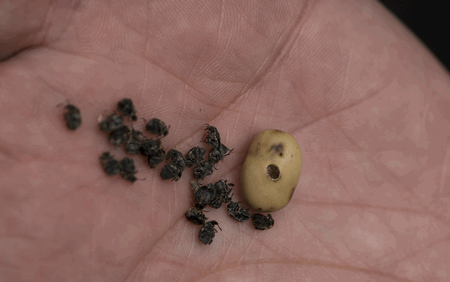PGRO field results make controlling the bruchid beetle easier

Bruchid beetle control in field beans is set to become easier thanks to results emerging from new research at the Processors and Growers Research Organisation.
The pest, whose larvae leave unsightly holes in beans, can ruin the potential of crops destined for human consumption, especially those for the lucrative export market to the Middle East, explains the PGRO’s Anthony Biddle.
“Up to now, control in the field has been erratic and generally poor.”
But a new three-year project started last year, funded through DEFRA’s Sustainable Arable Link Programme, is already providing useful pointers to more reliable control, says Dr Biddle.
“The objectives are to improve control by combining spray application, timing and pest monitoring.”
Genetic varietal resistance
A longer-term study to see whether there is any genetic varietal resistance in bean types which can be exploited is also under way.
The bruchid life cycle is quite simple, he explains.
“Adults fly into bean crops from their overwintering sites, such as hedgerows and verges, in late May or June.
“Having fed on the flowers’ pollen for about a fortnight they become sexually mature and the females lay eggs on the surface of developing pods.
“Their favourite pod length seems to be 3-5cm.”
Their almost transparent, cigar-shaped eggs, about 0.5mm long, have flattened irregular edged bases which fix them to the pod surface.
The eggs, laid singly or in small groups, are often concentrated on pods set on the lower third of the plants, notes Dr Biddle.
After a few days, the larvae hatch and bore through the pod wall into the developing seed. There they feed and grow inside a circular chamber just beneath the seed coat.

Tricky to tackle until now, bruchid beetles which can wreck bean samples, could be easier to deal with in future.
As the seeds mature and dry, the fully grown larvae pupate. Eventually the emerging adults bite through the seed coat leaving the circular holes that cause sample rejections.
“It’s impossible to control the larvae while they hatch because they penetrate the pod immediately beneath the egg case,” explains Dr Biddle.
“You can ease the damage by reducing egg laying, but this means killing the adults before the eggs are laid, and the timing of the spray is critical.”
The latest work began with field scale trials on spray quality, crop penetration and examining the possibility of insecticide resistance.
Spray timings
Further experiments compared spray timings with those driven by a French researchers’ model based on the temperatures that trigger egg-laying.
“The results showed that bruchid beetles are still susceptible to pyrethroid insecticides and there are no signs that resistance has developed,” says Dr Biddle.
Spray timing remains the key, he stresses.
Using the French model, treatments were made when the first lowest pods were about 2cm long.
Application
Sprays were applied once the first pods were visible and after two consecutive days when the daytime temperature was at least 20C, and were repeated 7-10 days later.
The resulting damage was much less than where the crop was sprayed earlier in cooler conditions, he notes.
“This is the first time that such a significant reduction in damage has occurred in trials.”
Good spray penetration through the crop is clearly important to control the beetles as they stop feeding and start to lay, he adds.
Beating bruchids:
- Wait until beans have developed first early pods
- Spray when temperature at least 20C on two consecutive days
- Use high volumes through angled or twin cap nozzles.
- Repeat after 7-10 days.
Treatments using high water volumes through conventional nozzles were ineffective because the big drops stayed mostly in the top canopy.
Through angled or twin-cap nozzles, however, the spray spread evenly throughout the canopy and crucially down to the flowering stems, says Dr Biddle.
“There were significantly fewer beetles left alive after that approach compared with using 200 or 400 litres/ha through standard nozzles.”
Lab work at Rothamsted Research has started to pinpoint the chemical signals attracting bruchids to beans and to each other, he adds.
“And NIAB has begun assembling many parent and exotic bean breeding lines to assess resistance characteristics.”
Visit the PGRO website for a new PGRO technical information sheet.
Project organisations
The £644,582 project is led by PGRO, with academic partners Rothamsted Research and NIAB, and industrial partners HDC, KWS UK, Frontier Agriculture, Nickerson-Advanta, Wherry & Sons, Syngenta Crop Protection, Bayer CropScience, Velcourt, Raynham Farming Co and Oecos.

